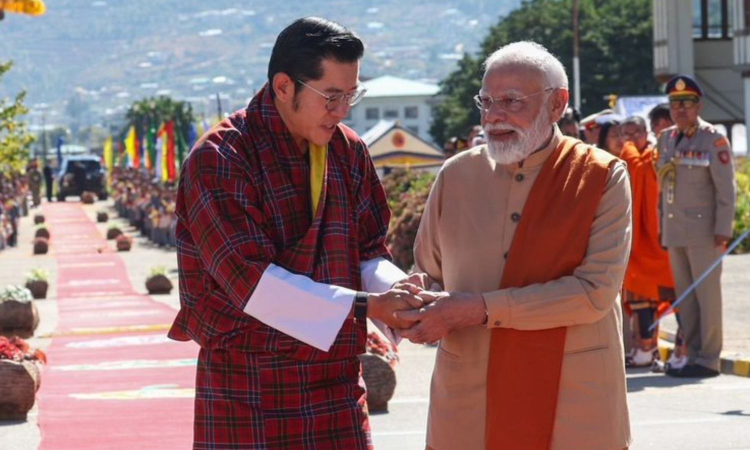Editorial: India reinforces Bhutan ties
In recent years, China has been making perceptible moves in expanding its influence in countries like Bhutan and Sri Lanka, which are inclined towards India, unlike Pakistan, which has been hostile and leans more towards Beijing.

Modi in Bhutan Credit: (PM Modi X handle)
CHENNAI: It would have been one of those periodic, scheduled visits in the past, but Prime Minister Narendra Modi’s two-day visit to Bhutan assumes special significance due to the need for a renewed focus and a bit of course correction in its Neighbourhood First policy.
In recent years, China has been making perceptible moves in expanding its influence in countries like Bhutan and Sri Lanka, which are inclined towards India, unlike Pakistan, which has been hostile and leans more towards Beijing. During his visit, Modi leveraged trade and development assistance to Bhutan to strengthen the bilateral relationship. Consequently, the prime minister expressed unwavering support for Bhutan’s economic development and sustainable growth.
India will be extending support to Bhutan’s 13th Five-Year Plan (2024-29), which envisages the possibility of emerging as a High Income Gross National Happiness (GNH) economy in a decade. To achieve this goal, the country will be focusing on substantial investments in strategic transport infrastructure, such as roads, bridges, airports and railways, so that enhanced connectivity will boost economic development and productivity.
India will be playing an important role in the establishment of cross-border rail links (Gelephu-Kokrajhar and Samtse-Banarhat). Already, two other projects, namely Immigration Check Post at Darranga and the Inland Waterways Terminal and Multimodal Logistics Park in Jogigopha, were operationalised in November 2024 and March 2025, respectively.
India has been helping Bhutan in the hydropower sector and has been touted as a mutually beneficial initiative wherein India gets clean, renewable energy while Bhutan earns export revenue. In the past, the 1,020-MW Tala Hydroelectric Project, one of the biggest joint projects between the two countries, was funded, with 60 per cent grant and the rest as a loan by India.
Now the King of Bhutan, Jigme Khesar Namgyel Wangchuck, joined Modi in the inauguration of the 1020-MW Punatsangchhu-II Hydroelectric Project, which has been described as a testament to friendship and exemplary cooperation. It will be seen if Indian companies will step up to engage with Bhutan’s energy sector, which will get a concessional Line of Credit of Rs 4,000 crore to fund its energy projects.
The Himalayan kingdom has always been strategically important to India as a buffer state against China. One of India’s concerns relates to the Siliguri Corridor, which is close to the Doklam region, which witnessed the 2017 73-day military stand-off between India and China, which, after prolonged discussions, resulted in disengagement.
Bhutan has its own security concerns, and India, as its primary strategic partner, has been engaged in bilateral security cooperation and border management. The issues range from the future roadmap for Integrated Check Posts, maintenance of boundary pillars and regulating cross-border movement to mobile signal spill over.
Bhutan has been maintaining friendly relations with China and is keen on resolving its border issues with its northern neighbour, and experts say it has made considerable progress in this regard. Given New Delhi’s keenness to support and sustain defence cooperation with Bhutan, it would keep a hawk’s eye on Bhutan-China talks. Bhutan, on its part, would not want to antagonise either of its big neighbours and would tread cautiously in its relationships with the two countries. India, on the other hand, would do everything possible to further nurture and strengthen its time-tested bilateral relationship with Bhutan.
Reach us at editor.dtnext@dt.co.in



